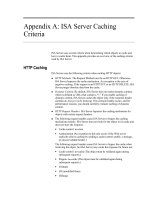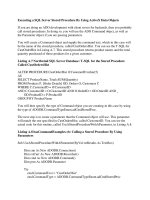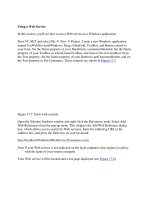Tài liệu Using a Single Stored Procedure to Update Multiple Changes to a SQL Server Database pdf
Bạn đang xem bản rút gọn của tài liệu. Xem và tải ngay bản đầy đủ của tài liệu tại đây (23.95 KB, 7 trang )
[ Team LiB ]
Recipe 8.11 Using a Single Stored Procedure to Update Multiple Changes to a SQL
Server Database
Problem
You need to update a SQL Server 2000 database with changes to multiple rows in a
DataSet by executing a single stored procedure.
Solution
Use OpenXML with an XMLdocument representing a DataSet of the changes made.
The schema of table TBL0811 used in this solution is shown in Table 8-10
.
Table 8-10. TBL0811 schema
Column name Data type Length Allow nulls?
Id int 4 No
Field1 nvarchar 50 Yes
Field2 nvarchar 50 Yes
Example 8-16 uses a single stored procedure:
SP0811_Update
Used to update the table TBL0811 with the changes made to the DataSet passed in
as an NText input parameter @data. The parameters @data and @datadeleted
contain an XML representation of a DataSet containing all updated and added
records and all deleted records, respectively. These parameters are parsed using
the system stored procedure sp_xml_preparedocument that returns a handle that is
subsequently used to access the parsed XML document. OpenXML is used to
update, insert, and delete the DataSet changes made to TBL0811. Finally, the
system stored procedure sp_xml_removedocument is used to free the memory
used by the parsed XML documents.
The sample code contains two event handlers:
Form.Load
Sets up the sample by creating a DataSet containing the contents of the table
TBL0811. The ColumnMapping for each column is set to MappingType.Attribute.
The default view of the table is bound to the data grid on the form.
Update Button.Click
Writes the XML representation of the added and changed records in the DataSet to
the stored procedure NText parameter @data and the XML representation of
deleted records in the DataSet to the stored procedure NText parameter
@datadelete. The stored procedure SP0811_Update is called to update the
database with the batched changes.
Example 8-16. Stored procedure: SP0811_Update
ALTER PROC SP0811_Update
@data ntext = null,
@datadelete ntext = null
AS
DECLARE @hDoc int
updated and inserted records
if @data is not null
begin
EXEC sp_xml_preparedocument @hDoc OUTPUT, @data
UPDATE TBL0811
SET
TBL0811.Field1 = XmlTBL0811.Field1,
TBL0811.Field2 = XmlTBL0811.Field2
FROM
OPENXML(@hDoc, 'NewDataSet/TBL0811')
WITH (
Id Integer,
Field1 nvarchar(50),
Field2 nvarchar(50)
) XmlTBL0811
WHERE
TBL0811.Id = XmlTBL0811.Id
INSERT INTO TBL0811
SELECT
Id,
Field1,
Field2
FROM
OPENXML(@hdoc, 'NewDataSet/TBL0811')
WITH (
Id Integer,
Field1 nvarchar(50),
Field2 nvarchar(50)
) XmlTBL0811
WHERE
XmlTBL0811.Id NOT IN (SELECT Id from TBL0811)
EXEC sp_xml_removedocument @hDoc
end
deleted records
if @datadelete is not null
begin
EXEC sp_xml_preparedocument @hDoc OUTPUT, @datadelete
DELETE TBL0811
FROM
TBL0811 INNER JOIN
OPENXML(@hDoc, 'NewDataSet/TBL0811')
WITH (
Id Integer,
Field1 nvarchar(50),
Field2 nvarchar(50)
) XmlTBL0811
ON TBL0811.Id = XmlTBL0811.Id
EXEC sp_xml_removedocument @hDoc
end
The C# code is shown in Example 8-17
.
Example 8-17. File: StoredProcedureMultipleRowsForm.cs
// Namespaces, variables, and constants
using System;
using System.Configuration;
using System.Windows.Forms;
using System.Text;
using System.IO;
using System.Data;
using System.Data.SqlClient;
private DataSet ds;
private const String TABLENAME = "TBL0811";
private const String STOREDPROCEDURE_NAME = "SP0811_Update";
// . . .
private void StoredProcedureMultipleRowsForm_Load(object sender,
System.EventArgs e)
{
ds = new DataSet( );
// Create the DataAdapter.
SqlDataAdapter da = new SqlDataAdapter("SELECT * FROM " + TABLENAME,
ConfigurationSettings.AppSettings["Sql_ConnectString"]);
// Load the schema and data for the table.
da.FillSchema(ds, SchemaType.Source, TABLENAME);
da.Fill(ds, TABLENAME);
// Columns in XML representation of data as attributes
foreach(DataColumn col in ds.Tables[TABLENAME].Columns)
col.ColumnMapping = MappingType.Attribute;
// This technique supports only update and insert; turn off delete
// records in the default view.
ds.Tables[TABLENAME].DefaultView.AllowDelete = false;
// Bind the default view of the table to the grid.
dataGrid.DataSource = ds.Tables[TABLENAME].DefaultView;
}
private void updateButton_Click(object sender, System.EventArgs e)
{
StringBuilder sb;
StringWriter sw;
// Create a connection and command for the update stored procedure.
SqlConnection conn = new SqlConnection(
ConfigurationSettings.AppSettings["Sql_ConnectString"]);
SqlCommand cmd = new SqlCommand( );
cmd.Connection = conn;
cmd.CommandText = STOREDPROCEDURE_NAME;
cmd.CommandType = CommandType.StoredProcedure;
// Inserted and updated records
if (ds.HasChanges(DataRowState.Added | DataRowState.Modified))
{
sb = new StringBuilder( );
sw = new StringWriter(sb);
ds.GetChanges(
DataRowState.Added | DataRowState.Modified).WriteXml(sw,
XmlWriteMode.WriteSchema);
cmd.Parameters.Add("@data", SqlDbType.NText);
cmd.Parameters["@data"].Value = sb.ToString( );
sw.Close( );
}
// Deleted records
if (ds.HasChanges(DataRowState.Deleted))
{
sb = new StringBuilder( );
sw = new StringWriter(sb);
// Get the DataSet containing the records deleted and call
// RejectChanges( ) so that the original version of those rows
// are available so that WriteXml( ) works.
DataSet dsChange = ds.GetChanges(DataRowState.Deleted);
dsChange.RejectChanges( );
dsChange.WriteXml(sw, XmlWriteMode.WriteSchema);
cmd.Parameters.Add("@datadelete", SqlDbType.NText);
cmd.Parameters["@datadelete"].Value = sb.ToString( );
sw.Close( );
}
// Execute the stored procedure.
conn.Open( );
cmd.ExecuteNonQuery( );
conn.Close( );
ds.AcceptChanges( );
MessageBox.Show("Update completed.",
"Multiple Row Update/Insert Stored Procedure",
MessageBoxButtons.OK, MessageBoxIcon.Information);
}
Discussion
OpenXML
p
rovides a result set view of an XML document allowing you to use the XML
document in a T-SQL statement in the same way a result set provider such as a table or
view is used.
The simple form of the OpenXML command is:
OPENXML(int iDoc, nvarchar rowPattern)
WITH (SchemaDeclaration)
The two input arguments are:
iDoc
The document handle of the internal representation of an XML document created
by using the system stored procedure sp_xml_preparedocument
rowPattern
The XPath query used to select the nodes in the XML document to be processed
The argument for the WITH clause is:
SchemaDeclaration
The format of the result set. If not supplied, the results are returned in an edge
table format representing the XML document structure in a single table.
The system stored procedure sp_xml_preparedocument reads XML as input text using
the MSXML parser and returns a handle that you can use to access the internal
representation of the XML document. The handle is valid for the duration of the
connection to the SQL Server or until it is reset. The handle can be invalidated and the
associated memory freed by calling the system stored procedure
sp_xml_removedocument. The syntax of the stored procedure is:
sp_xml_preparedocument hDoc OUTPUT, [xmlText], [xpathNamespaces]
The arguments are:
hDoc
An integer parameter that returns a handle to the internal representation of the
XML document.
xmlText
A text parameter that specifies the original XML document. The default value is
null which results in the return of a handle to an internal representation to an
empty XML document.
xpathNamespaces
A text parameter that specifies the namespace declarations used in row and
column XPath expressions in OpenXML. The default value is:
<root xmlns:mp="urn:schemas-microsoft-com:xml-metaprop">
The system stored procedure sp_xml_removedocument removes the internal
representation of an XML document specified by a document handle obtained
from the system stored procedure sp_xml_preparedocument and invalidates the
handle. The syntax of the stored procedure is:
sp_xml_removedocument hDoc
The argument is:
hDoc
An integer parameter that returns a handle to the internal representation of the
XML document.
For more information about the OpenXML command and the system stored procedures
sp_xml_preparedocument and sp_xml_removedocuemnt, see Microsoft SQL Server
Books Online.
[ Team LiB ]









